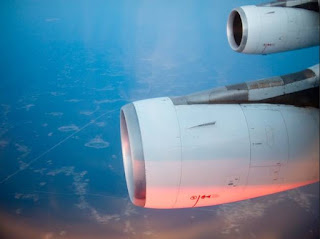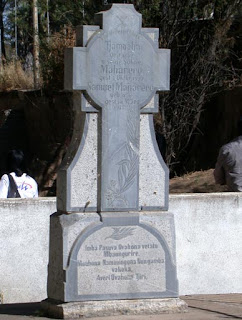PART 1 – from Windhoek to the Waterberg Plateau National Park
Anyway, we met on the morning of November 13, 2019 at the Windhoek international airport, about 45km east of Windhoek. Oh yes, there is still something that should perhaps be mentioned briefly - even if most people do know about that since long: Stay away from Air Namibia! Later there will certainly be an opportunity to tell you why that is so and why you should take this seriously.
Namibia has beautiful, sometimes even surreally beautiful landscapes and an exceptionally diverse wildlife. But Windhoek? The former understated colonial charm has suffered badly. Tasteful stylistic assurance and architectural skills had to give way to inflated urge for validity and overwhelming craving for status.
Thanks god, there are still pubs, restaurants and beer gardens that spread an attractive effect to locals as well as to visitors. And so we prefer to stay away from the coarse splendour of the "State House", the "coffee machine" and the various places "of hero worship", in this distinctive "Pyongyang style". Anyway: Confronted to alternative options like that, there is only one solution for us today: off to the beer garden!
 |
| Do you really have to do such hideous things to yourself in Windhoek? You don't have to - at least not yet... |
We would rather enjoy a real, cool beer in "Joe's Beerhouse".
And by the way:
Even a warm beer would be by far more real, than heroic stories
and curricula vitae, composed bythe
“bush-league court poets" of the government.
Ekki and Günter, top left, myself - sitting below: Anett, Heike and Martina (standing). >>>
<<< The carvers' market in Okahandja
The tomb for Tjamuaha, Maherero KaTjamuaha and Samuel Maherero. >>>
I almost forgot, but while we are on the subject of armed forces let's talk about: The "Museum of the Namibian People's Liberation Army". Just the forecourt alone is a feast for the eyes - unless you are overly "culture-sensitive".
But you can't get any further than this gate because this "museum" is closely guarded by SWAPO-soldiers and is not open to the public. It is a real treat for those who love contemporary North Korean architecture and hero worship. You just have to put that on celluloid. But see for yourself! (...thereby you save at least the long way to Pyongyang...).
 |
| North Korean "fine art" in Africa |
After just after about a 45 minutes' drive, the cones of the Omatako Mountains (2,286m above sea level) stick out of the plain, which reminds me always and again of the so called "Die Drei Gleichen" (the tree equals) in Thuringia. Especially when you look at it from the north and the Klein Omatako mountain peak (1,783m above sea level), which is further left from this perspective, comes into the picture. Only, the knight's castles on the peaks are missing. But the highest of the peaks reaches almost 2,300 meters in altitude. Well, admittedly, the road is already over 1,400 meters higher than the sea level.
After another 20 minutes of driving time, we pass the entrance to the private Okonjima nature reserve and drive another ten minutes until we get to that turn-off, from where we go eastwards.
<<< The Omatako Mountains on an oil painting by Helmut Lewin from 1947.
Over a hundred and fifty million years ago, the Waterberg was elevateted some hundred meters by tectonic forces from the interior of the earth, and formed thereupon a huge plateau - together with the Klein Waterberg and Mount Etjo, which is located about 70 kilometers to the west. Softer layers of rock were subsequently removed by weathering, whereas the Etjo, Klein Waterberg and the Waterberg Plateau, which are protected from above by harder material from erosion, remained as rudiments Subjacent impermeable layers ensure that the overlying sandstone can store water during the summer rainy season (from November to April), which is subsequently released relatively evenly by springs throughout the year. A biodiverse community of animals and plants has been living on it since millions of years, which could not exist in this form in the more distant arid regions.
The journey is it’s own reward >>>
Initially, the wildlife sanctuary was primarily used to create a safe haven for the largest African antelope, the Eland. In the 1980s, sable antelopes from Angola were also settled, which had almost been exterminated in their homeland by the long-lasting wars. Since the end of the 1980s, among others, the two African rhinoceros species, giraffes and buffalos have been brought back into an area that they had...
<<< Damara Dik-Dik (dwarf antilope) within the Waterberg Camp
Since then, the biodiversity on the Waterberg has grown significantly. In addition to the "usual suspects" - such as impala, kudu, wildebeest, giraffes, etc. - you can also find: red hartebeest, tsessebe, roan antelope, leopard, cheetah, the rarely seen aardvark... etc.
<<< Pied Crow
one of the most diverse biospheres in southern Africa. Except for elephants and lions, almost all large mammals are present. Within a forseeable future, Elephants and lions will not be resettled to the Waterberg anyway. Because for the elephant, with its enormous potential for destruction, the Waterberg biotope is too sensitive and...
<<< Elands on a waterhole on top of the plateau
...definitely too small. Yes, and lions? Then it would be over with the mountain hikes to the plateau. And finally, even nature conservation authorities want to preserve this area for the local population as a recreation area. Leopards, on the other hand, are not a major danger for hikers. Experience has shown that they largely avoid any contact to humans.
I had been on my feet since early morning and had actually thought about just going to bed. However, and even after I really have had been on the Waterberg plateau before quite often - both, climbing up on my own or together with gamekeepers in their Land Rovers: I really would have missed something today if I had not went with.
But in the late afternoon we came across two cheetahs. It was probably two brothers who warmed up in the rays of a slowly setting sun before looking for cover in the thick bushland.
Cheetahs are diurnal and have been indigenous up here on the plateau since long before humans and farms had settled there. I keep thinking about it because the Waterberg plateau (at least for me) doesn't look like a typical cheetah habitat.<<< Cheetahs enjoy the last rays of sunshine
At the end of the tour and
always an experience: A beautiful sunset in all the colors of the African
savannah, plus a small table, drinks and snacks. Camera with, binoculars with -
just my warming jacket - it's far down and laying on my bed. Gin and tonic with
ice cubes doesn't warm either, and so far north, the African twilight only
lasts for minutes.
<<< Shortly before the return trip to the camp
By the time we arrive at the camp, it is already pitch dark, but much warmer than on the plateau. Might be that's why, it took after dinner just a bit longer until we finally started our way - from the beer garden towards our beds.
Tomorrow morning we continue - towards ETOSHA NATIONAL PARK. To be seen in PART 2 of this tour "From Waterberg to Etosha National Park".
In this blog, we not only describe the tour
itself and what we experienced. We also want to report on aspects of nature
conservation, the history of the creation of the national parks and current
events in connection with it. The present geology of the respective landscapes
and their geological history also play an important role.
Klar – wir können in diesem Rahmen nicht alles ausführlich behandeln.
Sure - we cannot deal detailed with everything in this context. Therefore my request: Write in the comment column, your personal questions, which topics you are particularly interested in and what we should write more about.
We have
also dedicated two pages to these topics on our website - namely:
- nature
conservation and hunting .... >>>
-
.... as well as nature conservation and tourism ... >>>
Current travel offers - for self-drivers as
well as guided tours
- can be found on our website: www.paarl-safari.de
- or you send us an e-mail to: info@paarl-safari.de




















Keine Kommentare:
Kommentar veröffentlichen